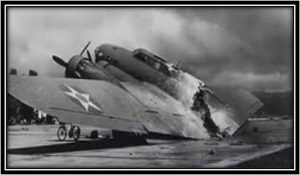This Day in Aviation History: “For the sake of humanity”
Contributor: Barry Fetzer
Sources: History.com. Ashai.com, The Mirror, USAF, USN, PBS
Today. Eighty-three years ago in 1941. The day before “a date which will live in infamy”.
We Americans like to think of ourselves as a people who don’t start wars, but we sure as hell can finish them. Some historians might disagree with that premise of Americans being a people who don’t start wars, because, like with many things, the answer to the question of whether Americans start wars is, “It depends.” It depends on what is meant by “starting a war”. We might opine that an economic embargo is “not an ‘act of war’”. Our enemies, though, might disagree.
According to History.com, “President Roosevelt—convinced on the basis of intelligence reports that the Japanese fleet is headed for Thailand, not the United States—telegrams Emperor Hirohito with the request that ‘for the sake of humanity,’ the emperor intervene ‘to prevent further death and destruction in the world.’
“The Royal Australian Air Force had sighted Japanese escorts, cruisers, and destroyers on patrol near the Malayan coast, south of Cape Cambodia. An Aussie pilot managed to radio that it looked as if the Japanese warships were headed for Thailand—just before he was shot down by the Japanese. Back in England, Prime Minister Churchill called a meeting of his chiefs of staff to discuss the crisis. While reports were coming in describing Thailand as the Japanese destination, they began to question whether it could have been a diversion. British intelligence had intercepted the Japanese code ‘Raffles,’ a warning to the Japanese fleet to be on alert—but for what?
“Britain was already preparing Operation Matador, the launching of their 11th Indian Division into Thailand to meet the presumed Japanese invasion force. But at the last minute, Air Marshal Brooke-Popham received word not to cross the Thai border for fear that it would provoke a Japanese attack if, in fact, the warship movement was merely a bluff.
“Meanwhile, 600 miles northwest of Hawaii, Admiral Yamamoto, commander of the Japanese fleet, announced to his men: ‘The rise or fall of the empire depends upon this battle. Everyone will do his duty with utmost efforts.’ Thailand was, in fact, a bluff. Pearl Harbor in Oahu, Hawaii was confirmed for Yamamoto as the Japanese target, after the Japanese consul in Hawaii had reported to Tokyo that a significant portion of the U.S. Pacific fleet would be anchored in the harbor—sitting ducks. The following morning, Sunday, December 7, was a good day to begin a raid.

B-17 “Flying Fortress” photographed after the attack cut in half. Courtesy USAF and PBS.
“‘The son of man has just sent his final message to the son of God,’ FDR joked to Eleanor after sending off his telegram to Hirohito, who in the Shinto tradition of Japan was deemed a god. As he enjoyed his stamp collection and chatted with Harry Hopkins, his personal adviser, news reached him of Japan’s formal rejection of America’s 10-point proposals for peace and an end to economic sanctions and the oil embargo placed on the Axis power. ‘This means war,’ the president declared. Hopkins recommended an American first strike. ‘No, we can’t do that,’ Roosevelt countered. ‘We are a democracy and a peaceful people.’”

A secondary explosion during the attack. Courtesy USN and The Mirror.
The next day, 83 years ago tomorrow on December 7, 1941, Japan attacked Pearl Harbor by air (and sea), “A date which will live in infamy.”

In the midst of the attack. Courtesy Asahi.com.
Onward and upward!
Sources: History.com, Ashai.com, The Mirror, USAF, USN, PBS







